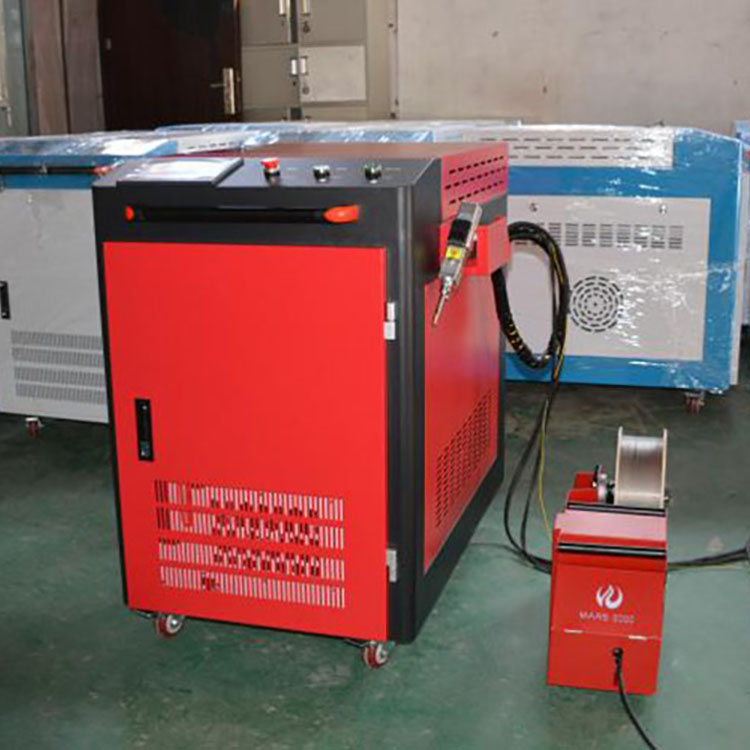
- English
- Español
- Português
- русский
- Français
- 日本語
- Deutsch
- tiếng Việt
- Italiano
- Nederlands
- ภาษาไทย
- Polski
- 한국어
- Svenska
- magyar
- Malay
- বাংলা ভাষার
- Dansk
- Suomi
- हिन्दी
- Pilipino
- Türkçe
- Gaeilge
- العربية
- Indonesia
- Norsk
- تمل
- český
- ελληνικά
- український
- Javanese
- فارسی
- தமிழ்
- తెలుగు
- नेपाली
- Burmese
- български
- ລາວ
- Latine
- Қазақша
- Euskal
- Azərbaycan
- Slovenský jazyk
- Македонски
- Lietuvos
- Eesti Keel
- Română
- Slovenski
- मराठी
- Srpski језик
How to choose the correct power output of laser welding machine
2024-07-11
Choosing the correct laser welding machine power output ensures high-quality welds, optimizes productivity, and minimizes defects. The selection process involves a thorough analysis of a variety of factors, including material properties, application requirements, and operating considerations. This section provides a step-by-step guide to help you choose the right power output for your laser welding machine.

Evaluate Material Properties
The first step in selecting the correct power output is to thoroughly understand the properties of the material to be welded.
●Material Type: Determine the type of material (e.g., steel, aluminum, copper, titanium) and its specific properties, such as reflectivity, thermal conductivity, and melting point. Materials with high reflectivity and thermal conductivity, such as aluminum and copper, require higher power levels.
●Material Thickness: Determine the thickness of the material. Thicker materials require higher power to achieve adequate penetration, while thinner materials can be welded with lower power settings. For example, materials less than 2 mm thick may require a 1-1.5 kW laser welder, while materials up to 5 mm thick may require up to 3 kW laser welders.
Define Welding Requirements
Next, outline the specific requirements for your welding application.
●Joint Configuration: Consider the type of joint (e.g., butt joint, lap joint, T-joint). Butt joints typically require less power than lap joints due to the difference in surface area and required penetration depth.
●Welding Speed: Determine the required welding speed. High-speed welding applications require higher power to deliver enough energy in a shorter time. Conversely, lower power settings enable slower welding speeds, which may be beneficial for precision tasks.
Evaluate Thermal Management Needs
Proper thermal management prevents defects and maintains weld quality.
●Heat-Affected Zone (HAZ): Consider the size of the HAZ you can tolerate. High power settings increase the HAZ, which may be detrimental to applications that require minimal heat effects. Lower power settings produce a smaller HAZ, which maintains the mechanical properties of the material.
●Cooling System: Make sure the welding machine has an adequate cooling system to dissipate heat, especially when operating at higher power levels. Efficient cooling prevents overheating and maintains the integrity of the machine and material.
Consider Application-Specific Factors
Different industries and applications have unique power requirements.
●Automotive: For welding thick steel or aluminum parts, power levels between 2-3 kW are typically required to achieve deep, strong welds in body panels and frames.
●Aerospace: Precise and high-quality welds are required on thin-walled structures and critical components, and power settings of 1.5-2 kW are typically used.
●Electronics Manufacturing: Micro-welding of delicate parts requires low power levels, typically between 1-1.5 kW, to ensure accuracy and minimal heat effects.
●Medical Device Manufacturing: Welding biocompatible materials such as stainless steel and titanium typically requires power settings in the 1.5-2 kW range to achieve clean, high-quality welds with minimal heat damage.
Conduct Material Testing
Testing sample materials can help determine the best power setting.
●Test Welds: Perform test welds using different power settings to observe the results. Analyze weld quality, penetration depth, and heat-affected zone extent.
●Parameter Optimization: Fine-tune welding parameters such as power, speed, and focus based on test weld results. This iterative process helps determine the best power setting for your specific application.
Consult an Expert
Take advantage of the expertise of laser welding professionals and equipment manufacturers.
●Manufacturer Recommendations: Consult with laser welding machine manufacturers to get their recommendations based on your application requirements and material properties.
●Industry Experts: Speak with industry experts who have experience with similar applications. Their insights can provide valuable guidance in selecting the right power output and optimizing the welding process.
Evaluate Economic Factors
Consider the economic impact of power selection.
●Initial Investment: Higher-power lasers generally have higher upfront costs. Evaluate the return on investment by considering increased productivity and potential long-term savings.
●Operating Costs: Higher power settings may result in increased energy consumption and maintenance costs. Balance these costs against the benefits of faster welding speeds and better weld quality.
Selecting the right fiber laser welding machine power output requires a detailed evaluation of material properties, welding requirements, thermal management, application-specific factors, and economic considerations. By conducting comprehensive material testing, consulting with experts, and carefully evaluating your specific needs, you can select the optimal power setting to ensure high-quality welds, increase productivity, and minimize defects. This comprehensive approach enables you to get the best results from your laser welding operation and tailor it to your unique application needs.



